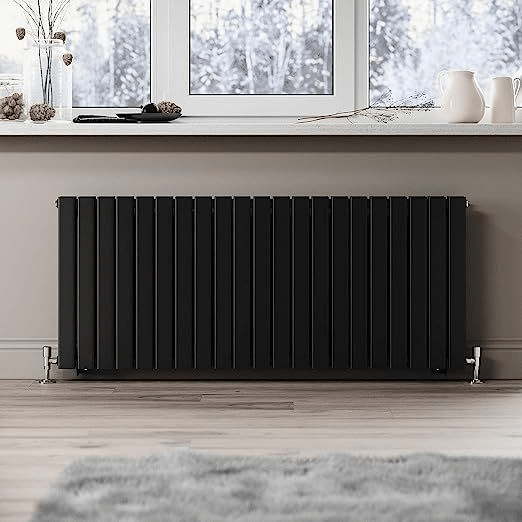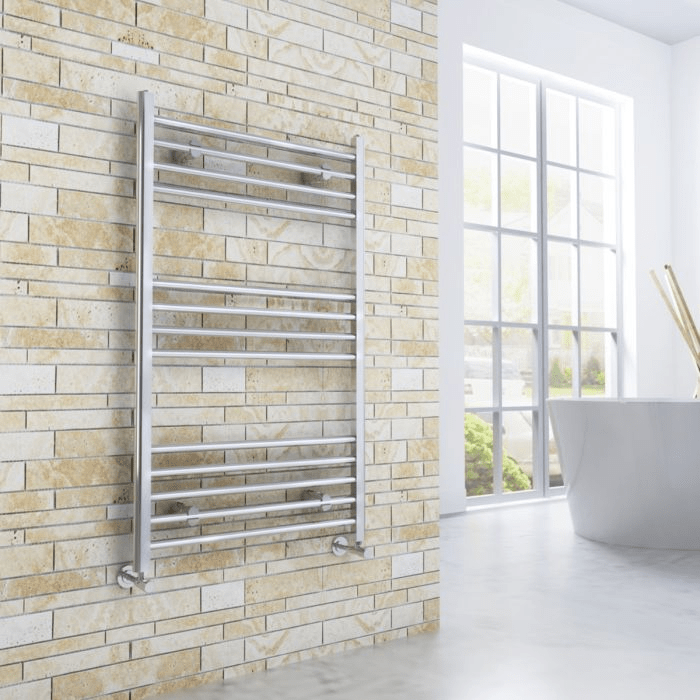Heating solutions are an essential consideration when designing modern bathrooms. The two most popular options include traditional radiators and dual purpose heated towel rails. Radiators efficiently warm spaces, while heated rails offer style and functionality by also drying towels. This article compares the advantages and disadvantages of selecting bathroom radiators versus towel rails.
Radiators and heated rails differ significantly in their heat output and capability to warm various sized bathrooms. Radiators tend to be superior for heating larger, open concept bathrooms that are more difficult to keep warm. Meanwhile, heated towel rails provide a stylish secondary heating source well-suited for small powder rooms.
When selecting between installing a radiator or towel rail, homeowners must consider several factors like bathroom size, efficiency, costs, and aesthetic preferences. The following sections compare these two common bathroom heating options to help determine the best choice.
What Are Bathroom Radiators?
Bathroom radiators are specialized heating units designed to warm small spaces like bathrooms and powder rooms efficiently. Vertical rectangular models take up less floor space compared to classic horizontal radiators. Compact radiators with towel racks also save space in small bathrooms.
These heating devices use hot water from the central heating system and cooling fins to emit warmth. Optional radiator covers boost safety and contribute to the room's design. The main advantage of radiators is their high heat output from fairly small units.
Types of Bathroom Radiators
When choosing the ideal heating solution for your bathroom, understanding the different types of bathroom radiators is essential. Each type offers unique features that cater to varying needs, including heat output, energy efficiency, and design. Let’s explore some of the most popular options available.
Vertical Radiators
Vertical bathroom radiators are slim, tall designs that reach towards the ceiling. This condensed footprint allows them to emit plenty of warmth while taking up less floor space than horizontal radiators. Popular dimensions for vertical models include heights of 30-40+ inches with narrow widths of 4-12 inches. These units mount directly on walls, and many have integrated towel racks or open shelves to add functionality to their slim shape.
Vertical radiator shapes work especially well in modern, compact bathroom spaces where wall space is limited. Their height and slim depth allow vertical radiators to become an attractive visual feature on an otherwise blank wall.
Horizontal Radiators
The most classic radiator style uses pipes running horizontally to maximize heat emission across a wide surface area. These units usually occupy space along the whole length of a bathroom wall below windows. Their shape allows heat to emanate evenly across an open space.
Horizontal bathroom radiators work well for heating larger, open concept bathroom spaces that need an extensive heat source. Their sprawling linear shape emits ample warmth from wall to wall to heat efficiently. A downside is their larger floor space footprint.
Compact Radiators
For small powder rooms and tight spaces, compact radiators provide powerful heating condensed into the smallest possible unit size and streamlined shape. Many compact bathroom radiator models include handy integrated towel bars or racks to add functionality within a petite footprint.
Their short yet wide horizontal shapes allow compact radiators to occupy minimal wall space while emitting temperatures high enough to heat up small rooms. For contemporary bathrooms lacking space for bulky fixtures, a compact radiator can be an ideal heating solution.
Designer Radiators
Beyond basic heating, designer radiators serve as stylish bathroom art installations that also provide warmth. Premium materials like brass, copper and stainless steel combined with ornate artistic details create stunning centerpieces. Designed radiators come in gorgeous finishes from polished chrome to dramatic matte black. Their facade hides efficient internal heating systems circulating hot water or electric elements behind the adorned exterior metalwork to heat.
Pros and Cons of Bathroom Radiators
Bathroom radiators offer numerous benefits. Let’s take a quick look at some of the most prominent benefits and drawbacks as well that come with them.
| Pros | Cons |
High heat output and BTU rating to effectively warm air | Take up more floor space than sleek heated towel rails |
Ability to heat larger, open concept bathrooms that are difficult to keep warm | Can make small bathrooms feel more cramped |
Durable steel and aluminum construction built to last for years | Need safety covers to prevent burns |
Energy efficient models available | Purchasing additional bathroom radiator covers can be expensive |
Provide comforting ambient warmth | Installation often requires professional assistance |
Available in compact sizes to conserve space | You need to get a separate towel rack for radiator |
Towel warmer radiators add functionality | Horizontal shapes limit furniture placement options |
Less aesthetic appeal compared to decorative towel warmers | |
Upfront costs higher than basic heated rails | |
Loud clanking sounds possible over time | |
Attractive finish requires diligent cleaning |
What Are Heated Towel Rails?
Heated towel railshave dual functionality - they dry towels using built-in towel racks while also emitting heat. Most models run on electricity, but some connect to central heating or have dual-fuel capabilities.
Heated towel rails contain an electric heating element that warms its surface along with the air around it. Styles range from modern stand-alone towel warmers to horizontal rails designed to mount onto existing radiators.
Types of Heated Towel Rails
Heated towel rails are a popular addition to bathrooms, combining functionality with style. They not only keep your towels warm and dry but also add a touch of elegance to your bathroom decor. Understanding the various types of heated towel rails can help you choose the right one for your space. Let’s explore the most common types available on the market.
Electric Towel Rails
Electric heated towel rails provide efficient drying and warming capabilities without connecting to existing pipe systems. Built-in electric heating elements powered by wall outlets gently warm the rail surface to temperatures perfect for drying damp towels. Popular in modern bathrooms, electric rails allow fingertip control over timing and heat settings. These convenient stand-alone units come in straight or curved rail styles, sizes ranging from 24 to 60 inches wide, and finishes from basic chrome to polished brass.
Dual Fuel Towel Rails
Offering flexibility, a dual fuel heated towel rail run on both electricity and hot water hydraulics from home heating systems. The dual-fuel functionality allows using central heating in colder months to warm plush towels, while switching to convenient electric mode in summer when central systems are inactive. Dual control heated rails are versatile for year-round towel warming and small bathroom heating.
Central Hydronic Towel Rails
Hydronic towel rail heating connect to home hot water heating systems through wall pipes to warm. Water flowing from a boiler passes through an internal radiator inside the rail to emit dry warmth perfect for preheating towels. Besides drying towels, hydronic rails add a decorative warming presence. Their inclusion taps into existing heating infrastructure without unnecessary electric costs.
Pros and Cons of Heated Towel Rails
Heated towel rails have become a popular feature in modern bathrooms, offering both practicality and a touch of luxury. While they serve multiple purposes, from heating to towel drying, it’s important to weigh their advantages and disadvantages before choosing one for your bathroom.
| Pros | Cons |
Dries towels efficiently | Lower heat output than traditional radiators |
Compact and stylish designs | Limited suitability as a primary heat source |
Ideal for small bathroom spaces | Wall-mounted rails reduce floor space |
Energy-efficient electric models available | Hydronic models need professional installation |
Even heat distribution along bars | Upfront cost more than basic towel racks |
Variety of sizes from 24 to 60 inches | Limited drying capacity compared to drying rods |
Towel warmer radiators add functionality |
|
Easy to install DIY options |
|
Silent operation without noise |
|
Heat Output Comparison
When it comes to effectively heating a room, radiators output far greater British Thermal Units (BTUs) than heated towel rails. A mid-sized bathroom radiator may emit 3000 BTU, capable of raising air temperature by up to 68°F. Meanwhile, most heated rails generate less than 1000 BTU - enough for a small powder room but not an entire bathroom.
However, towel rails are extremely efficient supplementary heat sources for bathrooms with other heating elements like underfloor systems. Their lower electrical use makes heated rails one of the most environmentally options.
Best Scenarios for Each Option
When deciding between bathroom radiators and heated towel rails, it’s important to consider the unique characteristics and requirements of your bathroom. Both options have their strengths, and the best choice often depends on factors like bathroom size, climate, and personal preference. Below, we’ll explore the best scenarios where each option excels.
When to Choose a Radiator
The extra heat capacity of radiators makes them the first choice for larger bathrooms, especially with poor insulation or drafty windows. Homeowners that require abundant warmth will appreciate a radiator's high BTU output.
When to Choose a Heated Towel Rail
Meanwhile, compact heated towel rails suit small, modern bathrooms where their stylish looks matter more than max heat output. As a supplementary heating method, towel rails work perfectly in bathrooms with other primary heat sources included. But if the amount of heat you get is not sufficient enough, you should get a small radiator for bathroom.
Combining Both Heating Methods
The best of both worlds, some large bathrooms incorporate radiators for heating the actual room along with heated towel rails nearby. This allows for warmth and towel drying. Dual fuel heated rails that run on both electricity and hot water are fantastic for year-round use.
Conclusion
As you can see, radiators offer unbeatable heating capabilities necessary for warming spacious bathrooms exposed to drafty conditions. For smaller bathrooms, efficient heated towel rails provide style and secondary warmth perfect for design-focused powder rooms. Homeowners should evaluate their bathroom size, heating requirements, and budget when deciding between these two popular options.
Whether you are interested in buying a radiator or a heated shower rail, feel free to take a look at the options available at Elegant Showers. Then you can find the right product to cater to your needs.




















Validate your login